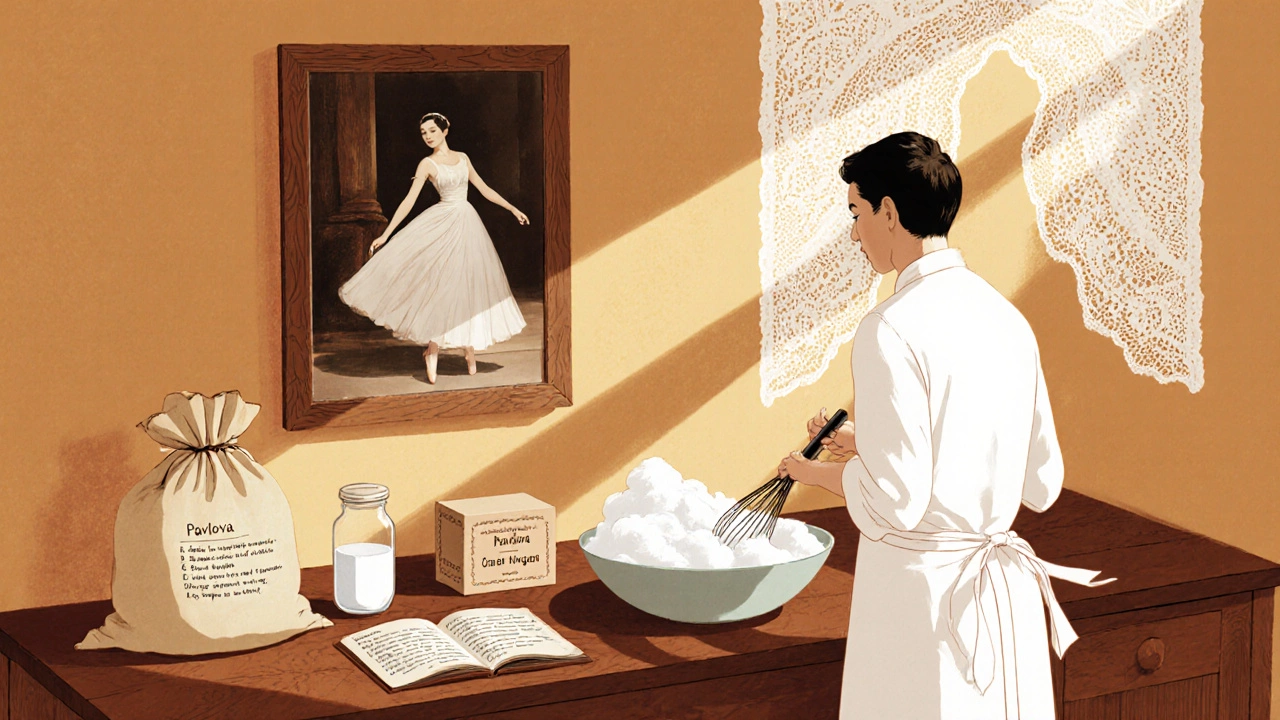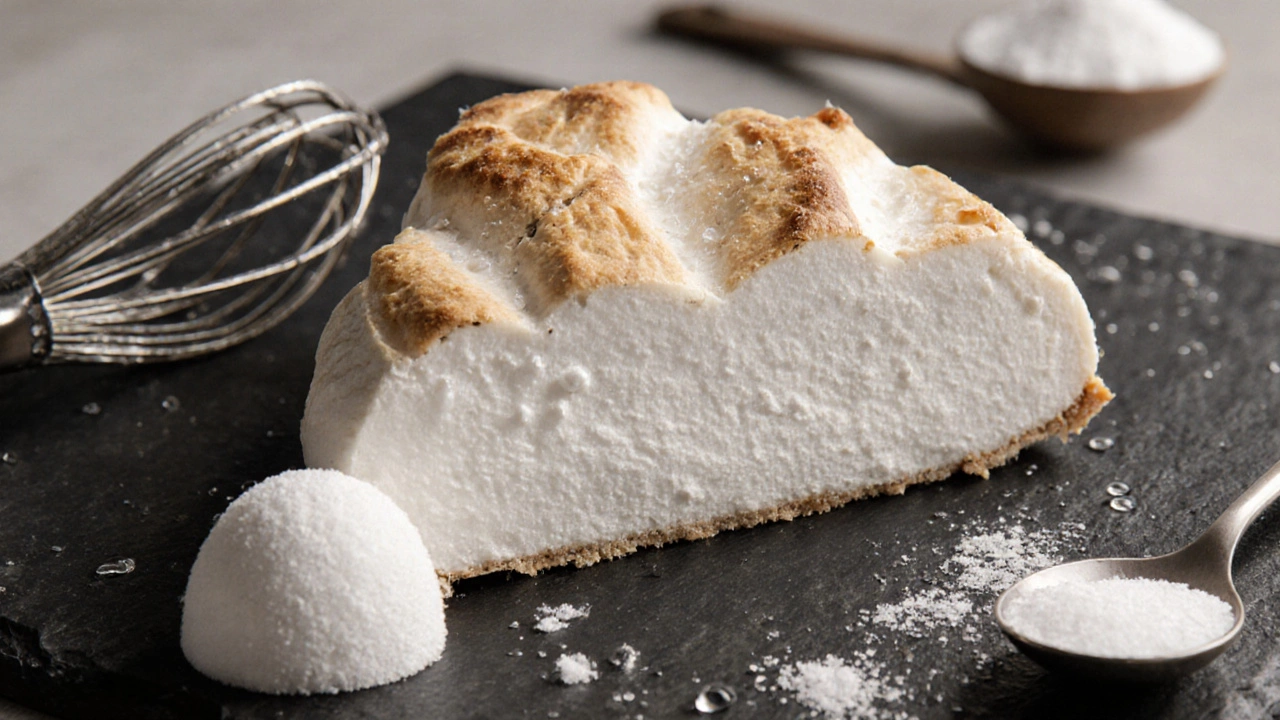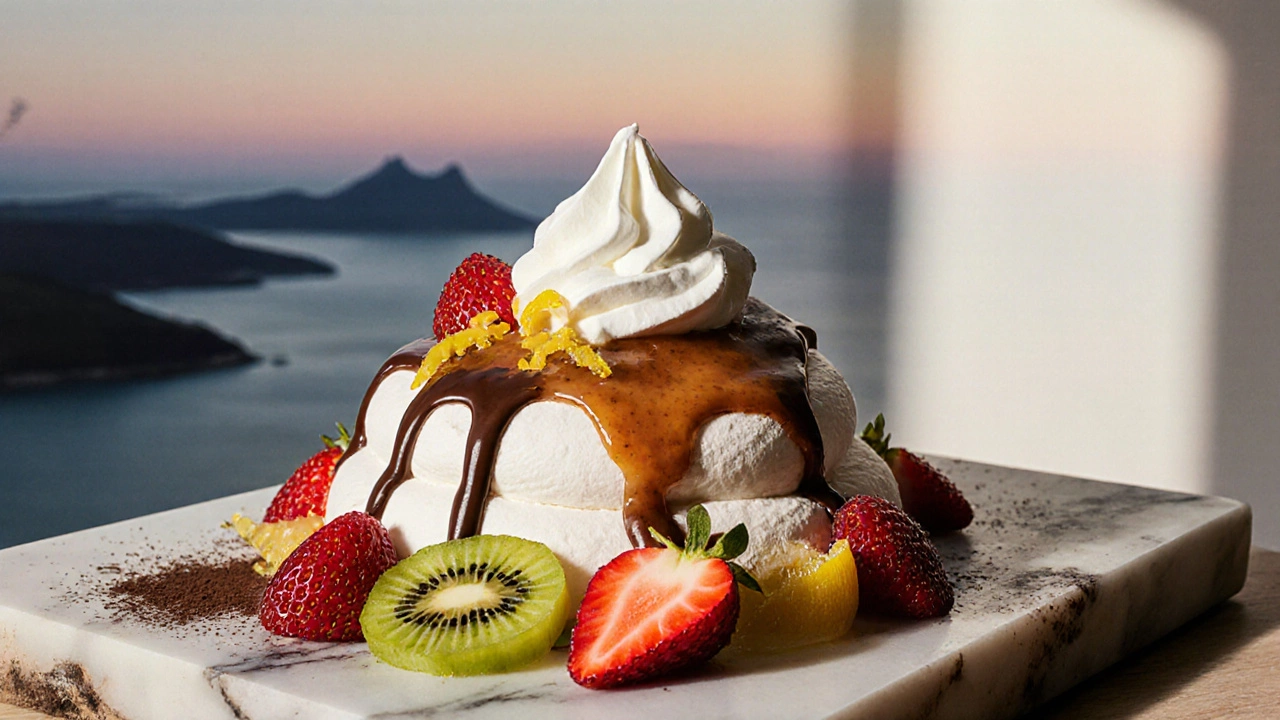
Pavlova Baking Time Calculator
Baking Settings
Baking Guide
Results
Key Takeaways
- Pavlova gets its signature crisp‑outside, marshmallow‑inside texture from a precise meringue technique.
- The dessert originated in the 1920s and is claimed by both New Zealand and Australia.
- Fresh fruit like kiwi and berries aren’t just garnish - they balance the sweet base and add acidity.
- Low‑heat baking and a slow cool‑down are critical to avoid cracks.
- Simple tweaks (adding cornstarch, vinegar, or cocoa) let you customize flavor without losing the classic feel.
What Is Pavlova?
When you hear the word Pavlova is a meringue‑based dessert named after the Russian ballerina Anna Pavlova, you probably picture a crunchy shell topped with soft, airy centre and a rainbow of fruit. It’s essentially a giant meringue that’s been engineered to stay crisp on the outside while staying marshmallow‑soft inside. The base is made from whipped egg whites, sugar, and a few stabilizers, then baked at a low temperature for a long time. The result is a dessert that feels like biting into a cloud wrapped in a wafer.
Origin Story and the Great Rivalry
The story begins in the early 1920s, when Anna Pavlova toured Australia and New Zealand. Local chefs wanted to honour her grace, so they created a delicate dessert that mirrored the ballerina’s lightness. Both countries publish recipes from the 1920s, but the exact birthplace remains hotly debated. In 1985, New Zealand’s New Zealand published a government‑backed report confirming the first printed recipe came from a Wellington hotel.
Australia, however, points to a 1935 recipe from a Melbourne café. The rivalry adds a cultural layer that makes the dessert special-eating pavlova can feel like taking part in a friendly national story.

The Science Behind the Texture
Two key ingredients create the crisp‑soft contrast: egg white is the protein‑rich component that, when whipped, traps air and forms a stable foam and sugar is the stabilizer that prevents the foam from collapsing by binding water molecules. Adding a pinch of vinegar or an acid like cream of tartar strengthens the protein network, while cornstarch is a dry thickener that absorbs excess moisture, keeping the interior soft but not soggy.
During baking, the outer layer loses moisture quickly, forming a thin, crunchy crust. Inside, the lower temperature and humidity allow the foam to stay supple. The secret is a slow, steady heat (around 120°C / 250°F) followed by a gradual cooling period, usually inside the turned‑off oven. Rushing the cooling process creates condensation, which cracks the crust.
Core Ingredients and Their Roles
- Egg whites - provide structure and lift; use room‑temperature whites for maximum volume.
- Caster sugar - dissolves fully into the foam; fine crystal size reduces grainy texture.
- Cornstarch - helps retain a soft centre; typical ratio is 1tsp per 4egg‑white whites.
- White vinegar - stabilizes the foam; a teaspoon per 4egg‑white whites is enough.
- Fresh fruit - kiwi, strawberries, passion fruit, and berries add acidity and moisture, balancing the sweetness.
All the dry ingredients should be sifted together before folding into the whipped whites. This ensures an even distribution and prevents lumps that could create weak spots in the crust.
Classic Toppings and Modern Twists
The traditional topping is a generous heap of whipped cream followed by sliced kiwi and berries. Kiwi is especially popular in New Zealand because its bright green hue mirrors the dancer’s costume, but the fruit also adds a subtle tartness that cuts through the sweet base.
If you want to experiment, try these variations:
- Chocolate Pavlova - add 2tbsp cocoa powder to the dry mix for a deep mahogany hue.
- Citrus Pavlova - fold in finely grated lemon zest for a fragrant lift.
- Nutty Pavlova - sprinkle toasted almond slivers on the crust before baking for extra crunch.
- Vegan Pavlova - replace egg whites with aquafaba (chickpea brine) and use a plant‑based sugar. The technique stays the same.

Common Pitfalls and Pro Tips
Even experienced bakers fall into traps. Here are the most frequent issues and how to avoid them:
- Cracked crust: Usually caused by sudden temperature change. Keep the oven door slightly ajar during cooling.
- Over‑whipping the whites: The foam becomes grainy and loses elasticity. Stop when soft peaks form, then add sugar gradually.
- Undissolved sugar: Leads to gritty texture. Rub the sugar between your fingers; it should feel like fine sand before folding.
- Humidity: High humidity can make the crust soggy. Bake on a pre‑heated pizza stone to draw moisture away.
Pro tip: Use an oven thermometer. Many household ovens run hotter than the dial indicates, which can over‑brown the outer shell.
Quick Checklist for a Perfect Pavlova
| Step | What to Do | Why It Matters |
|---|---|---|
| 1 | Separate eggs, bring whites to room temperature. | Warmer whites whisk faster, yielding more volume. |
| 2 | Whisk to soft peaks, add vinegar, then sugar gradually. | Gradual sugar addition keeps the foam stable. |
| 3 | Sift sugar, cornstarch, and optional cocoa together. | Even coating prevents grainy spots. |
| 4 | Shape a 20‑cm circle on parchment, create a small well in the centre. | The well holds cream and fruit without sliding off. |
| 5 | Bake at 120°C for 1hour, then turn off oven and leave door ajar for 1hour. | Low, slow heat creates the crisp‑soft contrast. |
| 6 | Cool completely before topping. | Prevent steam from softening the crust. |
Mini‑FAQ
Frequently Asked Questions
Can I make pavlova ahead of time?
Yes, the meringue base can be baked and stored in an airtight container for up to 2 days. Add the whipped cream and fruit right before serving to keep everything crisp.
Why does my pavlova get soggy after a few hours?
Moisture from the fruit and cream seeps into the crust. To avoid this, keep the fruit separate until the last minute, or use a thicker layer of whipped cream that acts as a barrier.
Is there a gluten‑free option?
Absolutely. Pavlova is naturally gluten‑free because it contains only egg whites, sugar, and cornstarch. Just double‑check any toppings you choose.
Can I substitute regular sugar with brown sugar?
Brown sugar adds moisture and can prevent the crust from hardening properly, leading to a gummy interior. Stick with caster or superfine white sugar for the classic texture.
What’s the best fruit combination?
A mix of kiwi, strawberries, and passion fruit offers a balance of sweet, tart, and aromatic notes. The acidity helps cut the sweetness of the meringue.